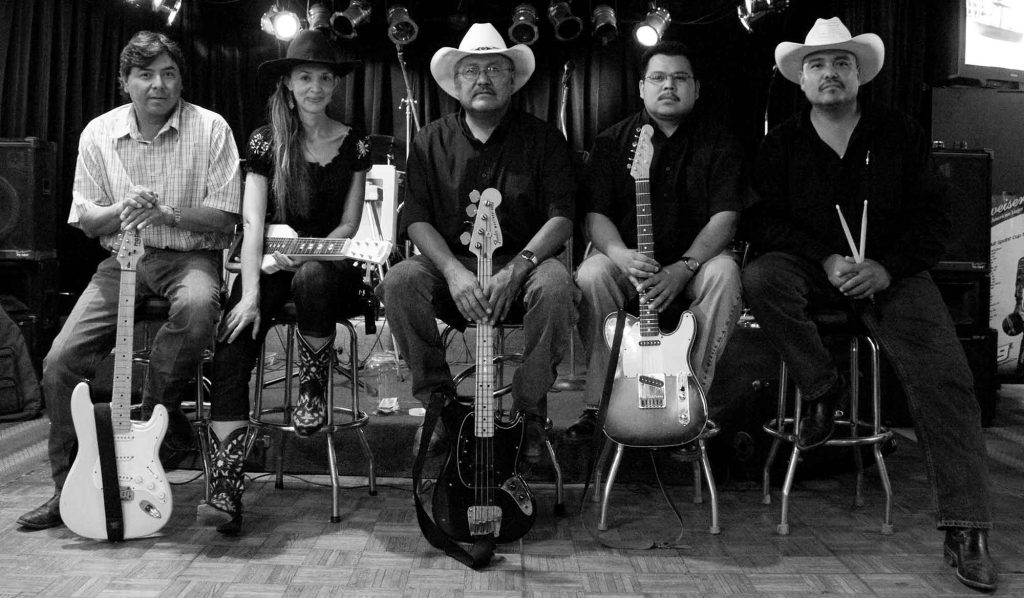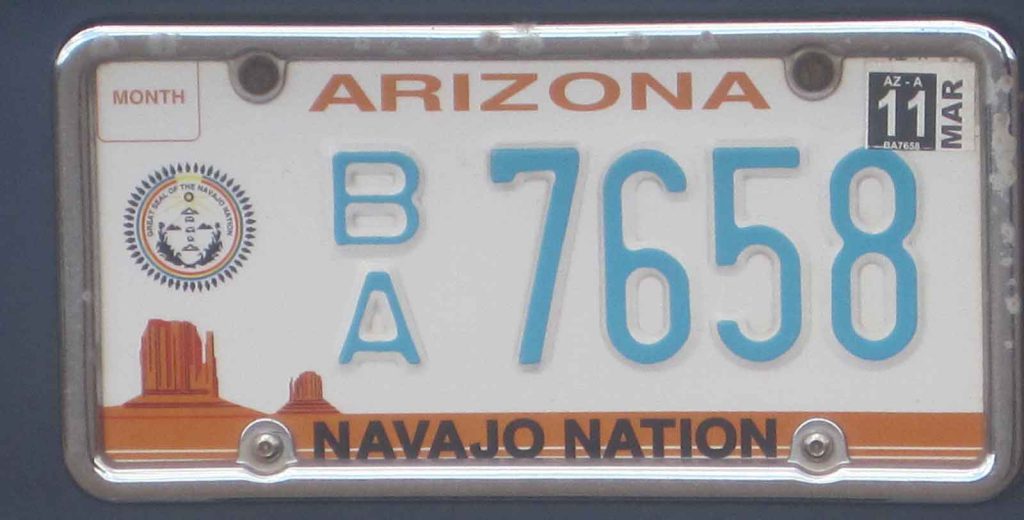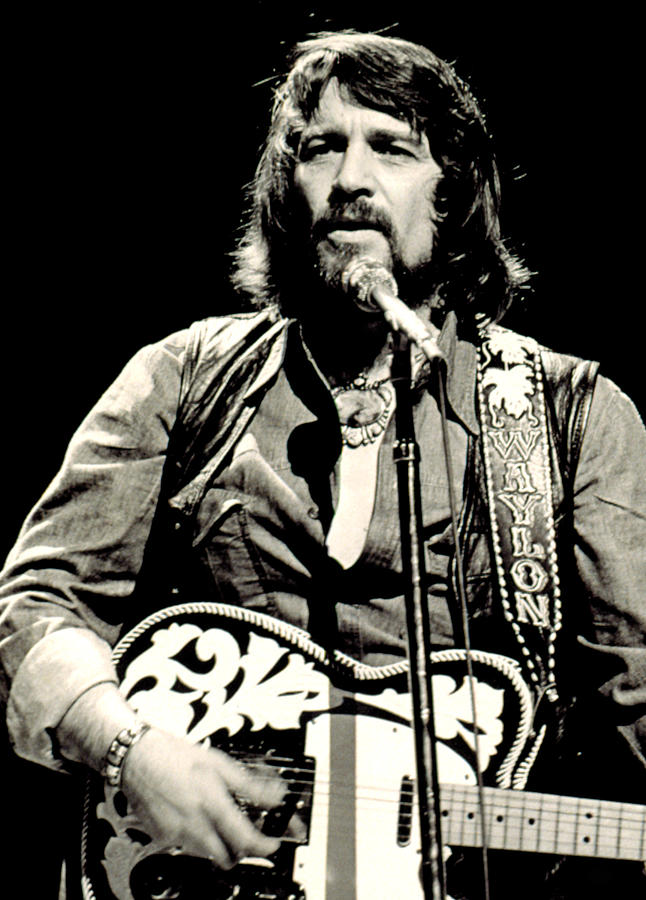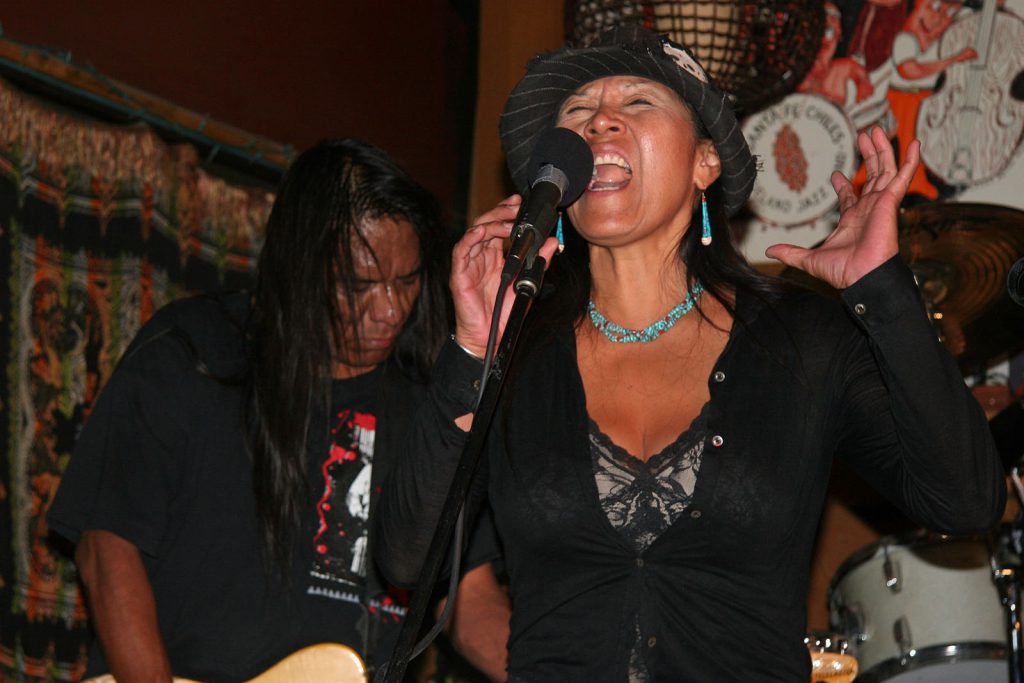Why Navajos Love Their Country Music

When I was 17, I worked as a summer park ranger at Canyon de Chelly National Monument, a park on tribal trust land on the Navajo reservation in northeastern Arizona. One evening, my supervisor invited me to a dance. Excited to be included in an outing with my Diné (Navajo) co-workers, I climbed into her truck, and we cruised to the community center gymnasium in Chinle.
High on a stage, singing tight harmonies in English spiced with Navajo, was a Diné country-western band. Around 200 people wearing Stetson hats and jeans were twirling one another counterclockwise, scooting their boots along the floor, then picking them up high on the quick steps. The dancers seemed to know the words to every song, singing along as the band crooned, “Oh shí baby hold me tight/ Won’t you stay with me tonight?”
After each song, the crowd whistled, called out “nááná” (encore), or—the most important sign of approval—stayed on the dance floor to kick up their boots to the next song. The sense of shared community and connection to the music was palpable. I’d entered a world that was completely unknown to me.
In many ways, my anthropology work since that night has been a long-term attempt to unpack the riddle of what I witnessed. How did Navajo cowboys and country musicians turn the stereotype of “cowboys and Indians” on its head? When did Indians become cowboys? What does country music performed by Navajo bands mean to Diné listeners? And what might this tell us about contemporary identities on the Navajo Nation?
After my first summer in Chinle, I held a variety of roles on the Navajo Nation: high school social studies teacher and volleyball coach, country music radio station deejay, Navajo language student, tribal college instructor, rancher, sheepherder, and community member. Each of these was united by a love of and a sense of connection and belonging to “the rez” (as sovereign Navajo homeland is sometimes affectionately called), even though I am non-Native.
Most significantly, in my 20s, I interviewed Navajo bands for a country music/Navajo language radio station (KTNN-AM 660), following select bands around the reservation and attending their shows. Eight years later, I returned to sing, play the lap steel guitar, and tour with three country-western bands based on the Navajo Nation: Native Country Band, Re-Coil, and The Wranglers. My hope was to learn more about this unique and vibrant country-western scene from the inside out.
Several years ago, I was sitting at a bar in the Navajo reservation town of Gallup, New Mexico, talking with Chucki Begay, the lead singer for a Navajo blues, rock, and soul band. She recalled the day she and her bandmate/partner, Richi Anderson Jr., dropped off their CD at KTNN, the radio station where I used to work. The Navajo deejay listened to the music but refused their request to play it on air. “You guys don’t sound Navajo enough,” he told them. “You should play country!”
The incident made Begay and her bandmates—all raised on the rez and fluent in Navajo—think about what it means to “sound Navajo.” As Begay sees it, the deejay’s idea of sounding Navajo harkens back to the original Diné country bands in the 1960s and ’70s.
In those days, up to 500 people filled the chapter houses (similar to town halls), dancing to groups like The Fenders and The Wingate Valley Boys. Outlaw country singer Waylon Jennings was on the radio, influencing a generation of musicians. (I met a number of middle-aged Navajo men named Waylon, along with a Garth Brooks Yazzie and a Shelby Lynne Henry.)
Jennings’ music still forms an emotional backbeat that reverberates through the reservation. Native Country drummer Arlondo Bia recalls when Jennings passed away in 2002. Arlondo Bia’s father, Native Country bandleader Tommy Bia, “got quiet” and withdrew from the family for four days (the standard Diné mourning period) to grieve and properly pay his respects to the artist who so profoundly inspired his musical path.
In listening to the lyrics of Jennings, Brooks, and others, it’s easy to see why country music resonates with Diné people. Navajo communities were ranching in the U.S. Southwest long before Anglo cowboys came onto the scene. “We’re the real cowboys,” many Navajo Nation citizens told me. The Diné have deep ties to their land, a rich and bittersweet past pierced by separation and loss but also resilience and a strong working-class identity. Country music is about love, loss, nostalgia for the past, and connections to land, family, and rural places. These themes are central to what it means to be Diné. What could be more Navajo?
So Diné musicians do not see country music as music belonging to outsiders. They don’t see Navajo country as an imitation of a style associated with whiteness and the rural American South. Rather, Diné citizens see country as a fundamentally Diné genre of music. In fact, Diné people have been listening to and performing country music for so long, country music in Navajo spaces can even be seen as “traditional” Navajo music. As one friend—a rancher, photographer, and social studies teacher—said to me, “Country music has always been Diné music.”
One day, a song I’d recorded played on the local radio station. The band Native Country and I had teamed up to sing Kitty Wells’ 1952 hit “It Wasn’t God Who Made Honky-Tonk Angels.” Betty (a pseudonym), a driver for a dialysis clinic, heard it and told me later how much she enjoyed my voice. Then she whispered to me, “I could tell it wasn’t a Navajo singing.” When I asked how, she said my voice sounded “professional” and didn’t have a rez accent.
Another time, I was playing softball with the Bia family and decided to energize the team by playing old Native Country songs on my iPod. The song I played, “Room at the Top of the Stairs,” is not perfectly mixed—lead singer Tommy Bia’s voice is muffled and drowned out by the loud guitars—but the energy and emotion shines through. As Tommy Bia approached from across the softball field, he heard the music grow louder and clearer. Just when he heard his recorded voice crack slightly on a low note, he exclaimed, “I just said to myself, Now that sounds like a rez band. And I was right!”
“Native bands,” as they’re locally referred to, pride themselves on an older recording aesthetic, emulating the first bands in the 1950s and ’60s, and their low-tech, make-ends-meet live sound and production value. So even if they have access to higher-end recording equipment or PA systems, they continue that old-school aesthetic as an expression of Diné cultural continuity and a way to connect with the past. The recordings often sound tinny and imperfect. They are sometimes not mastered (the final stage in the professional recording process). But that is often the point.
Diné singers’ voices are often deeply inflected with “rez English,” meaning Navajo language pronunciation carries into the speaking or singing. Though Diné musicians sing in English, the music scene is a source of Native language reclamation and revitalization. Country-western musicians, typically age 40 and older, are often fluent in their heritage language. Navajo is ever present during rehearsals and on stage in the form of humorous quips and wordplay between songs. Navajo words like shí (my) are often mixed into the lyrics.
Thus, performing country-song covers creates a place for Navajo language and social cohesion, where musicians, dancers, and listeners weave connections with one another and with what it means to be Diné. Through language and connection, country music becomes an expression of Diné cultural sovereignty, or self-governance.
Navajo country music is culturally intimate, meaning it’s a genre performed by and recorded for Diné audiences, and not necessarily intended for non-Native ears such as mine. When it is heard by outsiders, the Diné often express some embarrassment, as it’s not the “right” kind of Navajo music that outsiders associate with Native communities. And while this music is deeply loved by many (mainly Navajos age 40 and older), it is considered by many younger Native listeners to sound “rezzed out,” “hick,” or even “rezneck.”
It’s also associated with some old-fashioned sensibilities—for better or worse.
Begay challenges many traditional notions about Navajo music. It isn’t just her low, tortured voice and her blues bowler hat; it’s the fact that she’s a female bandleader. Soon after she and Anderson posted their contact information on a website promoting Navajo bands, the frontman of a well-known Native country and gospel group posted this comment on the site: “Chucki Begay does not belong in music. Native women don’t belong in music.”
Most of the 50 or so active bands on the reservation are all-male, and during my fieldwork, only four female vocalists performed publicly. I was one of them. Begay explained that in Navajo tradition, women are the property owners and the prime decision-makers in the home, so men assert their autonomy outside the home in male-dominated spheres such as politics, the military, and musical groups. The masculine music scene therefore gives men a sacred domain of expression. So there’s resistance to female voices among both bands and listeners. Re-Coil, another band with a female vocalist, found it difficult in the past to get gigs on the rez, so they mostly play off-reservation in Arizona, Colorado, and New Mexico.
Country bands on the Navajo Nation feature Diné musicians and those from neighboring Native nations—Ute Mountain Ute, Southern Ute, Jicarilla Apache, Isleta Pueblo, San Carlos Apache, and White Mountain Apache—in addition to Anglos, Hispanics, and African Americans. But there is a keen awareness of “blood quantum,” the perceived amount of Navajo or Native American “blood.” The fact that I, as a non-Native, didn’t have any “Navajo blood” led to interesting conundrums. For example, one band asked me to put a feather in my hat so I could tell people I was Lumbee, a tribe from North Carolina that is seen by many Diné people as looking more “white.”
Native bands are mostly family bands, with members related to one another either through birth or kinship, an elaborate system of obligations and reciprocities known as k’é. Band and family loyalties demand that you commit to one band only. Going against this is often read as a betrayal. In the bands I played with, members, who were often connected by “blood” and by clan, felt a doubly intense sense of obligation and responsibility for one another. This made it almost impossible to “fire” a band member, even if they weren’t pulling their weight, musically speaking. It also meant band members weren’t replaceable. If someone couldn’t play a gig, often the band simply wouldn’t play the gig.
Like country musicians in other parts of the U.S., Southwestern Native band musicians often identify as working class and work a variety of blue-collar (and sometimes white-collar) jobs. Only two of the 50 bands are able to support themselves by playing music. Among the bands I played with, musicians were employed as bronc riders, maintenance workers and supervisors, security officers, biomedical engineers, tribal government officials, teachers, medical staff, substance abuse counselors, sheepherders, and ranchers. Despite this range of work and socioeconomic strata, most musicians identify as rural and are deeply connected to the “rez.”
For bands like Native Country, “sounding Navajo” or “sounding rez” is a way to belong to the community and to signal this belonging through their music.
All of this is tied into what it means to “sound Navajo.” The imperfections and low-fi sound signal an eschewing of upward mobility and a commitment to the people who have loved Native country music for decades. The rez accent and Navajo words bond performers and listeners to their heritage and history as Diné people, a self-governing nation within a nation. So for bands like Native Country, “sounding Navajo” or “sounding rez” is a way to belong to the community and to signal this belonging through their music.
But the Navajo music scene, and what it means to sound Navajo, are changing. Diné people have always been known for their ability to adapt and strategically morph while retaining a strong core sense of who they are as Diné people. This is evident in the histories of Diné weaving, Diné adoption of non-Navajo people into their kinship structure (now known as “adopted clans”), and Diné music.
For younger generations, this openness to change is expressed in the active metal, rap, and hip-hop scenes on the Navajo Nation. For example, Def-i raps in English and Naát’áaníí Nez Means raps in English and Navajo about significant issues of the day, including water rights, social and political marginalization, and tribal sovereignty. Def-i is also often backed by a sophisticated Diné-led jazz combo known as the Delbert Anderson Trio (DAT). The circle of belonging is expanding.
In January, 23 years after I attended my first country-western dance in Chinle, I returned to the Navajo Nation to give a book talk at a tribal college in Crownpoint (T’iis Ts’óóz Ndeeshgizh or Slender Cottonwood Gap), New Mexico. This is where I began my ethnographic fieldwork, playing with Diné singer Candice Craig and her band, The Wranglers, and where the seeds of my identity as an anthropologist working in the Navajo Nation were planted.
I gave a talk focused partly on my book, The Sound of Navajo Country: Music, Language, and Diné Belonging. I also invited Craig to join me for some songs spotlighted in the book. She sang Merle Haggard’s “Okie From Muskogee,” changing the final chorus to “I’m proud to be a Navajo from New Mexico/ a place where all you squaws can have a ball./ We still weave our rugs down at the chapter house/ and Garden Deluxe is still the biggest thrill of all.” Then she sang Gretchen Wilson’s “Redneck Woman,” tweaking the chorus from “redneck” to “redskin” but leaving the other lyrics the same. It’s interesting how little the country song needed to be changed to reflect Craig’s working-class identification as a Diné woman.
I’d also written a number of original songs informed by my time living on the Navajo Nation. I sang “Inez” from my first album, recounting the life story of my supervisor at Canyon de Chelly and what it means to her to be a dual citizen, both Diné and American. I performed another original, “Lucinda” (Shelter), a love song to a rez truck I loved, herded sheep with, and then lost. What could be more country?
This process of “bringing songs back home” to the community about which they are written is powerful. It is, in a sense, the ultimate litmus test for me as to whether I got the song, and the ethnographic (sense-bound) details, right. The audience—a mix of vocational students from the college, old friends, former students, and colleagues from Crownpoint and the other tribal college where I taught—was intently focused. Listeners recorded the songs on their phones, feeding back lines that moved them and engaging with the songs’ political implications as they related to being Diné.
The audience also connected deeply with the book and with Craig’s songs, relating life stories that dovetailed with the themes of belonging, blood quantum, music genre, and language stigma. One student commented that the concept of blood quantum values people with lighter skin over those with darker skin. And because people must have a minimum of one-quarter “Navajo blood” to be enrolled in the Navajo Nation—no matter how strongly they identify as Diné—the notion of blood quantum makes Navajo people smaller, not just in population, but in their mentality toward other Navajos. Who is to say, she asked, who is authentically Diné? And who gets to decide?
The conversation, the reading, and the performance represented a complete homecoming for me, a return to one of the places I love most. It’s also a place where I—a Scandinavian American woman who was raised in a Luddite community in western Massachusetts by two parents born overseas—have felt the most at home, the most welcome, and the most accepted for all my idiosyncrasies and my sense of unbelonging as an American.
My book, and the songs Craig and I sang, catalyzed the exact conversations I’d most hoped they would foster among Diné citizens and U.S. citizens more broadly. For that, and for all the beautiful music I’ve been privileged to be a part of, I am extremely grateful. Ayóo bąąh ahéé’ nisin (thank you).




































